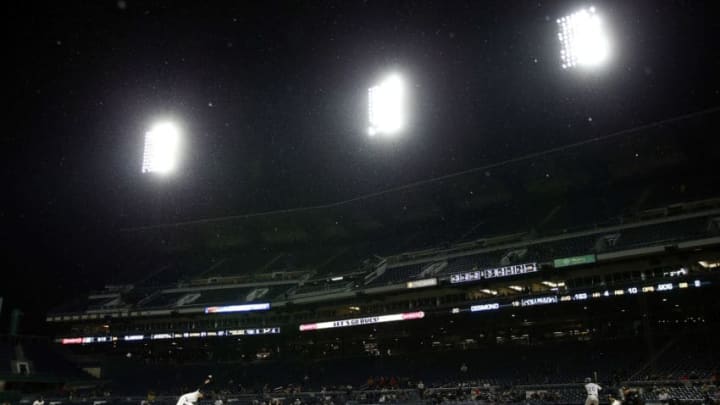Inflation is part of life, purchasing power changes and it’s an important area to recognize. Without adjusting for inflation, information is lost on what a team is actually spending in context of year-to-year.
Inflation is the changing of prices and the reduction in purchasing power an individual has on a certain market basket, or in non economic terms the goods and services sold on a market at a given price. The changes in prices of the basket is the inflation rate.
Looking at inflation in baseball is something that I recently helped Kevin Creagh of The Point of Pittsburgh in calculating. In short, the sum of the opening day payrolls in baseball are the given market basket. The calculation of the Baseball Price Index (BPI) is the same calculation of the Consumer Price Index (CPI, and an index of market baskets in the economy). Simply the formula is the new price of the market basket divided by the price in the base year (in this case 2010) and multiplied by 100 to get on a scale of 100. The inflation rate is then (new price-base year price)/100, and those values I calculated for TPOP (which can be seen in the above link) are:
| Inflation in Opening Day Payrolls 2010-2018 | |||
|---|---|---|---|
| Year | Opening Day Payroll | BPI | Inflation Rate |
| 2010 | $2,808,369,236 | 100.00 | 0.00% |
| 2011 | $2,876,676,553 | 102.43 | 2.43% |
| 2012 | $3,010,668,965 | 107.20 | 7.20% |
| 2013 | $3,183,572,547 | 113.36 | 13.36% |
| 2014 | $3,430,046,397 | 122.14 | 22.14% |
| 2015 | $3,757,838,898 | 133.81 | 33.81% |
| 2016 | $3,903,750,767 | 139.00 | 39.00% |
| 2017 | $4,100,091,926 | 146.00 | 46.00% |
| 2018 | $4,068,836,950 | 144.88 | 44.88% |
The BPI becomes handy when calculating the deflator, which is then used to calculate the “real” price of the market basket in a given year. In this case, we want to calculate the real opening day payroll given the change in purchasing power, with the real year being in 2018 (ie converting everything into 2018 dollars). The deflator in each is simply the BPI (or, if calculating the purchasing power for the economy, the CPI) divided by the year in which you want the real rate, in this case 2018. The deflator values are as followed:
| Deflator 2010-18 | ||
|---|---|---|
| Year | BPI | Deflator |
| 2010 | 100.00 | 0.69 |
| 2011 | 102.43 | 0.71 |
| 2012 | 107.20 | 0.74 |
| 2013 | 113.36 | 0.78 |
| 2014 | 122.14 | 0.84 |
| 2015 | 133.81 | 0.92 |
| 2016 | 139.00 | 0.96 |
| 2017 | 146.00 | 1.01 |
| 2018 | 144.88 | 1.00 |
Taking the nominal opening day payrolls (what the payroll was in a given year) divided by the deflator, the real value of the payroll is produced in 2018 dollars. For the Pirates, their real payrolls (rounded to the nearest dollar) are:
| Pirates Opening Day Payrolls 2010-18 | |||
|---|---|---|---|
| Year | Nominal Payroll | Deflator | Real Payroll |
| 2010 | $39,068,000 | 0.69 | $56,602,714 |
| 2011 | $42,047,000 | 0.71 | $59,472,236 |
| 2012 | $51,932,333 | 0.74 | $70,185,131 |
| 2013 | $66,805,000 | 0.78 | $85,381,642 |
| 2014 | $71,929,333 | 0.84 | $85,325,006 |
| 2015 | $90,053,000 | 0.92 | $97,505,770 |
| 2016 | $99,945,500 | 0.96 | $104,172,107 |
| 2017 | $95,807,004 | 1.01 | $95,076,668 |
| 2018 | $86,340,000 | 1.00 | $86,340,000 |
And this is the real gall of Kevin’s article, a must read for understanding the context of the Pirates, especially with respect to how the club handled their Baseball Advanced Media money, and as he writes, “If the Pirates truly dock this ship at $75M on Opening Day as rumored, their payroll would only be 52.6% of the MLB average, a full 11% drop than just last year.” Using our inflation rates and calculating backwards (2018 dollar value multiplied by the deflator), a $75 million payroll in 2018 is the same as a $59.6 million payroll in 2010. This is where even the target of $100 million payroll is put into perspective. Without accounting for inflation, $100 million sounds great, but the cost of an opening day payroll has increased! Players cost more and that’s why inflation is important. A $100 million 2018 payroll would be the same as a $69 million payroll in 2010.
Adjusting for inflation is important, and below is an interactive tableau with filters for both team and division:
Calculating for inflation can’t be ignored in baseball, like it seemingly has been. A $100 million payroll in 2018 isn’t the same as it was in 2010. One of the biggest differences between the Pirates and their competitors is what they spend, especially in relation to when they’re in contention. In 2013, when the Reds had a winning season, their payroll in 2018 dollars was $137 million, or where the Pirates spent just $85 million to start the season, essentially the same as they did in 2018. Inflation is important in economics, and it certainly can’t be ignored in baseball.
